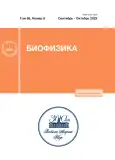A study on the radiosensitivity and induction of adaptive response in peripheral blood lymphocytes of patients with secondary immunodeficiency syndrome
- Autores: Rozanova O.M1, Smirnova E.N1, Belyakova T.A2, Strelnikova N.S2
-
Afiliações:
- Institute of Theoretical and Experimental Biophysics, Russian Academy of Sciences
- Branch “Physical-Technical Center” of P.N. Lebedev Physical Institute, Russian Academy of Sciences
- Edição: Volume 68, Nº 5 (2023)
- Páginas: 932-940
- Seção: Articles
- URL: https://journals.rcsi.science/0006-3029/article/view/233462
- DOI: https://doi.org/10.31857/S0006302923050137
- EDN: https://elibrary.ru/PHESWE
- ID: 233462
Citar
Texto integral
Resumo
Palavras-chave
Sobre autores
O. Rozanova
Institute of Theoretical and Experimental Biophysics, Russian Academy of Sciences
Email: rozanova.iteb@gmail.com
Pushchino, Moscow Region, Russia
E. Smirnova
Institute of Theoretical and Experimental Biophysics, Russian Academy of SciencesPushchino, Moscow Region, Russia
T. Belyakova
Branch “Physical-Technical Center” of P.N. Lebedev Physical Institute, Russian Academy of SciencesProtvino, Moscow Region, Russia
N. Strelnikova
Branch “Physical-Technical Center” of P.N. Lebedev Physical Institute, Russian Academy of Sciences
Email: strelnikova.ns@lebedev.ru
Protvino, Moscow Region, Russia
Bibliografia
- G. Olivieri, J. Bodycote, and S. Wolff, Science, 223 (4636), 594 (1984).
- И. Н. Когарко, А. В. Аклеев, В. В. Петушкова и др., Радиация и риск, 31 (1), 93 (2022).
- И. И. Пелевина, В. В. Петушкова, В. А. Бирюков и др., Радиац. биология. Радиоэкология, 59 (3), 261 (2019).
- Y. Gucguen, A. Bontemps, and T.G. Ebrahimian, Cell Mol Life Sci., 76 (7), 1255 (2019).
- F. Cortese, D. Klokov, A. Osipov, et al., Oncotarget, 9 (18),14692 (2018).
- F. Rodel, B. Frey, U. Gaipl, et al., Curr. Med. Chem., 19 (12), 1741 (2012).
- V. E. Balakin, S. I. Zaichkina, O. M. Rozanova, et al., Dokl. Biol. Sci., 374, 488 (2000).
- S. I. Zaichkina, O. M. Rozanova, G. F. Aptikaeva, et al., Int. J. Low Radiat., 2 (1-2), 1 (2006).
- S. M. J. Mortazavi, T. Ikushima, and H. Mozdarani, Iran. J. Radat. Res., 1 (1), 55 (2003).
- J. F. Barquinero, L. Barrios, M. R. Caballln, et al., Int. J. Radiat. Biol., 67 (2), 187 (1995).
- M. Ghiassi-nejad, S. M. Mortazavi, J. R. Cameron, et al., Health Phys., 82 (1), 87 (2002).
- M. Fenech, W. P. Chang, M. Kirsch-Volders, et al., Mutat. Res., 534 (1-2), 65 (2003).
- S. Bonassi, A. Znaor, M. Ceppi, et al., Carcinogenesis, 28 (3), 625 (2006).
- J. Hall, P. A. Jeggo, C. West, et al., Mutat. Res. Rev. Mutat. Res., 771, 59 (2017).
- R. S. Tuano, N. Seth, and J. Chinen, Ann. Allergy Asthma Immunol., 127 (6), 617 (2021).
- Р. М. Хаитов, Иммунология (ГЭОТАР-Медиа, М., 2016).
- K. Lumniczky, N. Impens, G. Armengol, et al., Environ.Int., 149, 106212 (2021).
- World Medical Association Declaration of Helsinki: ethical principles for medical research involving human subjects, J. Am. Med. Association, 310 (20), 2191 (2013).
- V. E. Balakin, S. I. Zaichkina, D. Y. Klokov, et al., Докл. РАН, 363 (6), 843 (1998).
- S. I. Zaichkina, O. M. Rozanova, G. F. Aptikaeva, et al., Nonlinearity Biol. Toxicol. Med., 2 (3), 213 (2004).
- M. Fenech, Mutation Res., 455 (1-2), 81 (2000).
- А. М. Серебрянный, А. В. Алещенко, В. Я. Готлиб и др., Радиац. биология. Радиоэкология, 47 (1), 93 (2007).
- M. Geric, J. Popid, G. Gajski, et al., Mutat. Res. Genet. Toxicol. Environ. Mutagen., 843, 46 (2019).
- Z. Siama, M. Zosang-Zuali, A. Vanlalruati, et al., Int. J. Radiat. Biol., 95 (6), 697 (2019).
- S. Ban, C. Konomi, M. Iwakawa, et al., J. Radiat. Res., 45 (4), 535 (2004).
- M. G. Andreassi, R. Barale, P. Iozzo, et al., Mutagenesis, 26 (1), 77 (2011).
- S. Bonassi, M. Neri, C. Lando, et al., Mutat. Res., 543 (2), 155 (2003).
- S. Bonassi, R. El-Zein, C. Bolognesi, et al., Mutagenesis. 26 (1), 93 (2011).
- R. El-Zein, A. Vral, and C. J. Etzel, Mutagenesis, 26 (1), 101 (2011).
- J. Depuydt, A. Baert, V. Vandersickel, et al., Int. J. Radiat. Biol., 89 (7), 532 (2013).
- M. Khattab, D. M. Walker, R. J. Albertini, et al., Mutat. Res. Genet. Toxicol. Environ. Mutagen., 820, 8 (2017).
- S. I. Zaichkina, G. F. Aptikaeva, O. M. Rozanova, et al., Environ. Health Perspect., 105 (Suppl 6), 1441 (1997).
- I. Seth, M. C. Joiner, and J. D. Tucker, Int. J. Radiat. Oncol. Biol. Phys., 91 (1), 82 (2015).
- M. Gerid, A. M. Domijan, V. Gluscid, et al., Mutat. Res. Genet. Toxicol. Environ. Mutagen., 810, 22 (2016).
- H. W. Gantenberg, K. Wuttke, C. Streffer, et al., Radiat. Res., 128 (3), 276 (1991).
- И. И. Пелевина, А. А. Алещенко, М. М. Антощина и др., Радиац. биология. Радиоэкология, 47 (6), 658 (2007).
- T. I. Ivanova, V. A. Khorokhorina, N. I. Sychenkova, et al., in Proc. 3rd Rus. Conf. with international participation "Radiobiological Foundations of Radiation Therapy" (2019), pp. 66-68.
- S. S. Sorokina, S. I. Zaichkina, O. M. Rozanova, et al., Biophysics, 61 (1), 144 (2016).
Arquivos suplementares









